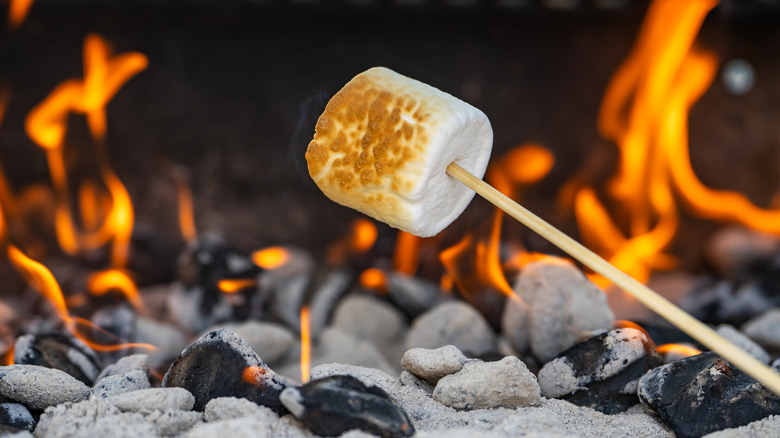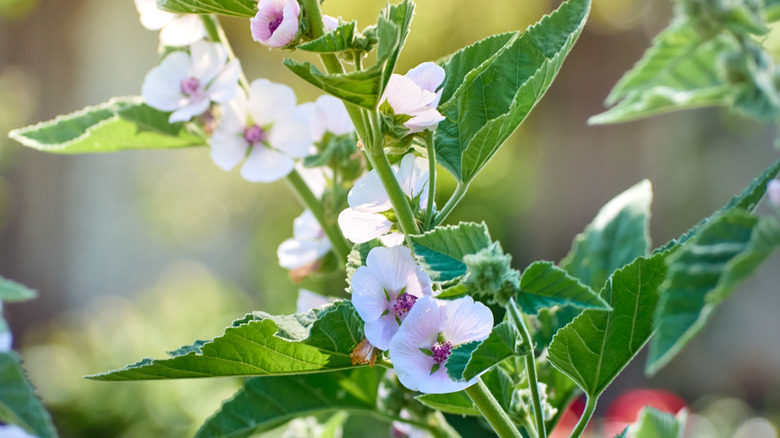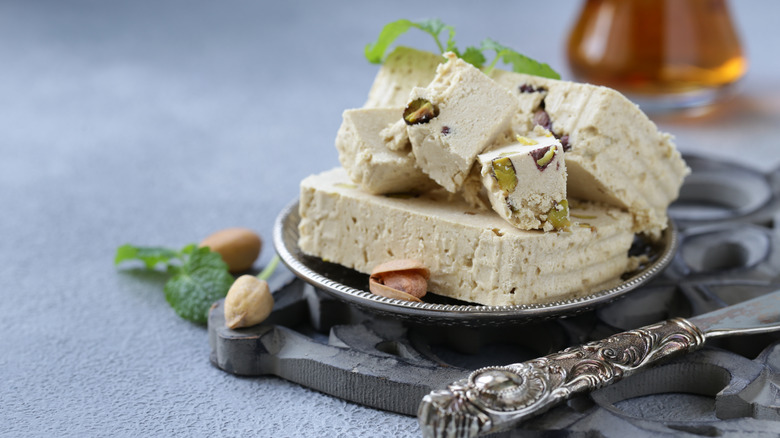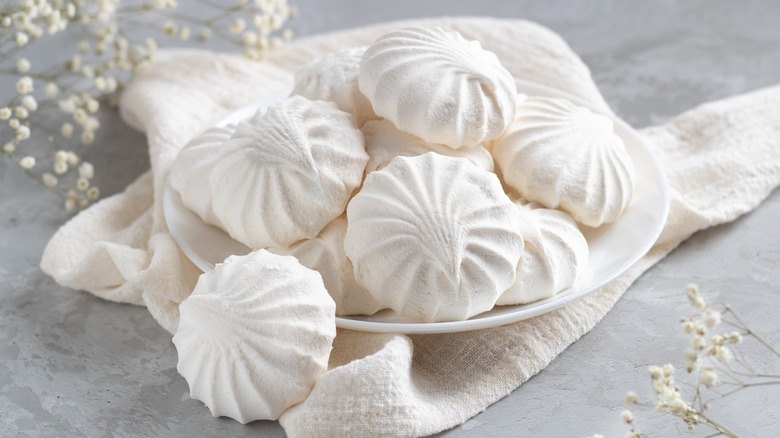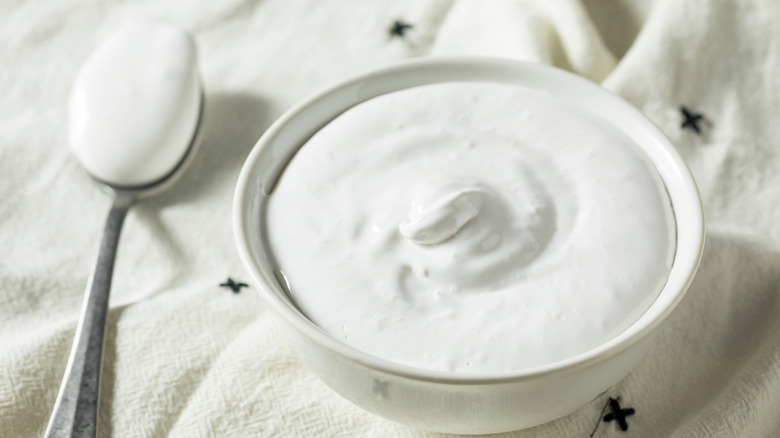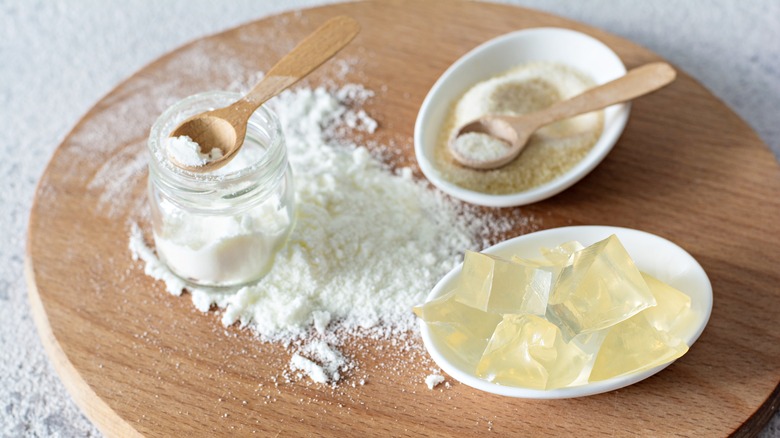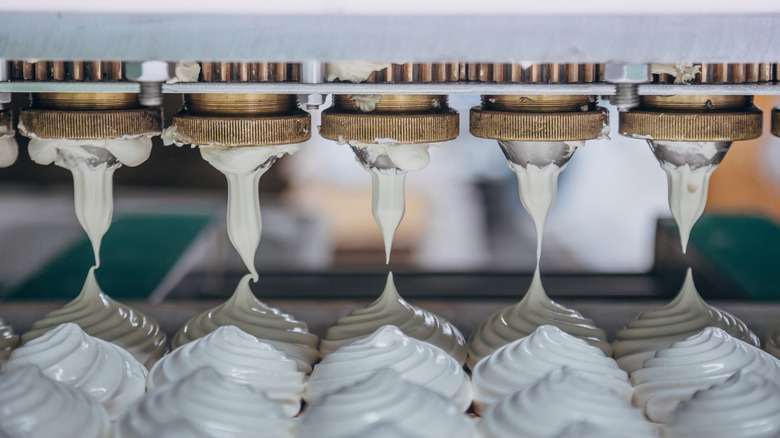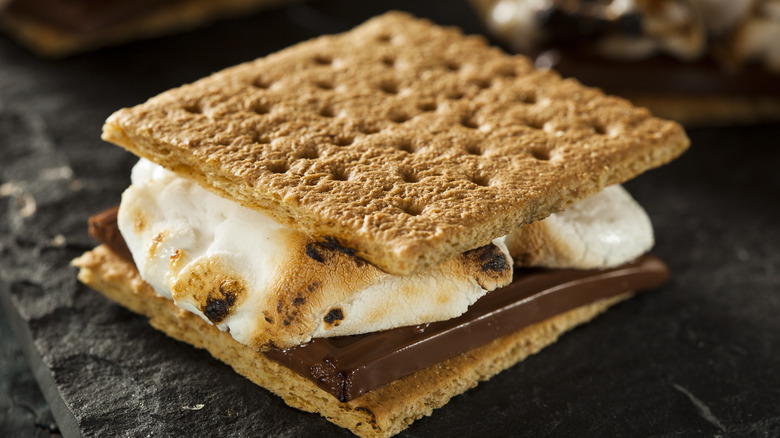As It Turns Out, Marshmallows Have Been Around Since Ancient Times
What do the ancient Greeks and Girl Scouts have in common? Marshmallows! That's right: Marshmallows are the chewy sweet treat that binds us all together. You may think the marshmallow is a relatively modern creation, but the truth is there have been versions of them dating back thousands of years.
Of course, these sweet treats have changed over time — and Americans today buy 90 million pounds of marshmallows per year, according to the National Confectioners Association. Holidays such as Easter are celebrated with marshmallow treats like Peeps, and there is even a national Toasted Marshmallow Day (August 30, in case you were wondering). Should you find yourself in Ligonier, Indiana, you can even celebrate these puffy delights at their annual marshmallow festival.
If you're wondering how marshmallows went from an ancient confection eaten by the Egyptians and Greeks to a treat enjoyed the world over, we don't blame you. The history is fascinating. Let's take a look at how marshmallows have been around since, well, ancient times!
The marsh mallow plant
Before we delve into the nitty-gritty of the marshmallow, it is important to understand that the original marshmallow confection was actually based on a plant, the marsh mallow. You can see where the name of the dessert derives from.
Marsh mallow is also known as Althaea officinalis. It is not the same as other mallows, such as Malva sylvestris. The marsh mallow plant grows in moist, marshy soil. It offers a green stock that can grow 4 to 5 feet tall with serrated green leaves and produce beautiful small, pink flowers. While today the plant is grown predominantly ornamentally, the entire plant is edible. Everything from the root to the flower can be eaten. The parts can be used for salads or, unsurprisingly, they can be used as a thickener for various dishes. That is because marsh mallow, particularly young marsh mallow and the roots of the plant, give a gelatinous consistency to the things made with them.
The plant is native to North Africa, Western Asia, and Europe. The gelatinous consistency of the roots was used to create confections, but in addition to simply being tasty, the plant offered more benefits which helped it take root.
Ancient Greece
The marsh mallow plant is known for its highly medicinal qualities. The name Althaea actually comes from the Greek name meaning "healing." It is no surprise, then, that the ancient Greeks used the marsh mallow for various medicinal purposes. Much of the plant was used to decrease inflammation and as a laxative. The ancient Greeks used marsh mallow sap to make concoctions that soothed sore throats. The famous Greek doctor Hippocrates used marsh mallows to cure everything from bruising to diarrhea. Roman doctors went on to use it for medicinal purposes, as well, expanding its use to toothaches and bug bites.
Of course, they were not the only ones who found the marsh mallow to be incredibly healing. Marsh mallow root is used in traditional Chinese medicine to help fight inflammation and ease coughing. All these amazing uses may seem far-fetched, but according to Healthline, there is some evidence to back up many of the claims.
The ancient Greeks also used the sap of the marsh mallow either on its own or mixed with drinks such as wine. This created a thick consistency and became one of the earliest forms of the treat we know as marshmallow.
Ancient Egypt
The next iteration of the marshmallow finds itself in ancient Egypt. This is when it truly starts to take shape as a candy and not just a medicinal tool.
More than 2,000 years ago in ancient Egypt, sap from the mallow was extracted and mixed with honey to turn it into sweet treats. Often other ingredients, such as grains and nuts, would be added, and the whole thing would be cooked into a cake-like substance. The sap from the plant adds a distinct gelatinous and gummy texture to the final treat. This is not an exact version of the marshmallow we have today, but it is an early precursor to what would become modern marshmallows.
These treats were given to Pharaohs and those in power and used as offerings for gods. It was illegal for commoners to consume the treat, so it was not widely available — unlike the marshmallows of today.
Of course, the marsh mallow was still used medicinally by the Egyptians. The plant grew well on the wet banks of the Nile River, giving them an excellent supply for both candy-making and medicinal uses.
Connection to halva
Halva, which can also be spelled halwa or any number of other ways, is a delectable sweet treat with Arabic roots. The name literally comes from the word "helew," which means "sweet." Found all over the Middle East, halva is a candy that offers a soft and somewhat fudgy consistency. It is often made out of sesame, but the flavors of halva have far-reaching roots.
The earliest written recipes for halva date back to the 13th century in the book Kitab al Tabikh, which translates to The Book of Dishes. With shared lands of origin, it is unsurprising then that marsh mallow found its way into many of the versions of halva and can still be found in versions today. The marsh mallow adds flavor as well as acts as a binder for consistency when it comes to halva. Marsh mallow root is sweet yet earthy, which plays nicely with the sesame paste tahini, which makes up the base of most halva.
French pate de guimauve
The first version of the treat that would be instantly recognizable as the fluffy marshmallow we know and love today comes from France in the mid-17th century. Marsh mallow root extract was mixed with whipped egg whites and sugar to create a small white and gummy candy. It was called Pate de Guimauve (which translates to "marshmallow paste") and was used to treat chest discomfort.
The egg whites and sugar mixed together created the basis of a meringue, which is a soft and sweet confection; the marsh mallow root gave it the squishy consistency. Of course, at the time, this was all done by hand, which was incredibly labor-intensive.
While pate de guimauve started as a medicinal item, it did not stay that way, and soon candy makers were making the confection for consumers as well. Recipes from the mid-1800s show that flavors such as orange blossom water were added, making the sweet treats even more of a delicious snack.
A sticky problem
As we mentioned, during this time period, marshmallows were still being made entirely by hand, either piped on their own or put into candy molds. This created a sticky problem because the candy was, well, sticky. And it took a long time to make the candy. Confectioners were desperate for a more efficient way to make marshmallows. Enter starch moguls. Starch mogul is a mold for sticky candies made entirely out of starch. This allows the candy to be piped, set, and then easily removed from the molds without sticking. Starch moguls were first used in 1899 and made a huge difference in the production of marshmallows and the safety of the employees.
This bump in production allowed the candies to really take off in the United States. Just 50 years later, the next evolution happened when Alex Doumak developed a mechanical system of piping large tubes of marshmallows, which would be cut into small pieces. This was done mechanically and, once again, vastly improved the number of marshmallows that could be made. The process gave us the cylinder-shaped marshmallow most think of today when thinking of marshmallows.
Gelatin replaced real marsh mallow
Of course, there was one other major evolution that happened to marshmallows during the late 1800s, and that is the throwing aside of real marshmallows. The 1800s saw a boom in manufacturing and food science; among those was the creation of easy-to-use, stable gelatin. Confectioners no longer had to extract the gelatin from bones; instead, they could use sheets or powders to easily add firmness to their products.
Unfortunately for marsh mallow, this meant that it was no longer needed, as using instant gelatin was faster and more controllable. The very ingredient that first made marshmallows possible was phased out almost entirely, and today most marshmallows are made using sugar, gelatin, and vanilla flavor.
This does mean that where marshmallows were once a completely plant-based product, they are no longer. The use of gelatin makes most mass-manufactured marshmallows unsuitable to vegans and vegetarians; and although companies such as Dandies and Trader Joe's do make vegan marshmallows, neither includes marsh mallow.
Industrialization
As the popularity of the candy grew, so did the commercialization and industrialization. Alex Doumak's company, which is largely credited with making marshmallows what they are today, is still around more than 100 years after its creation. Doumak's invention made marshmallows cheap and easy to prepare. Eventually, Doumak also acquired another big-name marshmallow brand, Campfire. Campfire takes credit for popularizing the idea of roasting marshmallows over an open flame to create a toasted marshmallow.
Of course, we cannot talk about marshmallows without talking about Peeps. No holiday would be complete without these marshmallow birds. Each year Peeps sell more than 700 million Peeps. This was only made possible by Ira "Bob" Born. When peeps were first invented, it took 27 hours to create just a single Peep. Born, though, was an innovator, and much like Doumak's invention helped create cylinder marshmallows, Born's creation revolutionized shaped ones. Born designed a machine that piped out Peep chicks automatically, eliminating the need to do it by hand. Industrializing the process made it possible to pump out Peeps in just six minutes, at a rate of more than 5 million per day.
S'mores
While Campfire marshmallows might lay claim to popularizing toasting marshmallows on an open flame, it is some resourceful Girl Scouts who get the credit for creating the favorite summertime marshmallow treat, s'mores.
In 1927 the Girl Scout handbook offered a recipe for "Some More." The recipe included 16 graham crackers, 8 bars of plain chocolate, and 16 marshmallows, all of which would be used to create eight Some More sandwiches, so named because they will leave you wanting some more. The name was eventually shortened to s'more, which was used for the first time in 1938, appearing in the Recreational Programs for Summer Camps.
It has been speculated the inspiration for the s'more was either mallomars or moon pies, both of which predate the s'more.
As a throwback to the Girl Scouts' contribution to s'more history, Little Brownie Bakers, one of the bakers for the Girl Scout cookies, offers a s'mores cookie, which does not contain any gelatin in the marshmallow-like filling.
Contribution to science
Marshmallows aren't just delicious, they have also contributed to science. In the 1960s, Walter Mischel developed a test that would later be known as the "marshmallow test." In it, children were placed in a room with a marshmallow. They were told that if they wanted to, they could ring a bell and eat the one marshmallow immediately — but if they waited, they could have two marshmallows.
The test was designed to see how children would respond to delayed gratification. They found that just one-third of the children were able to wait for the second marshmallow, but those who did had some surprising advantages. For example, children who were 4 or 5 years old who waited had higher SAT scores and social skills when they got older. They also found that children who did not wait had difficulty with attention and drugs later in life.
These findings had broad implications for the understanding of delayed gratification and development, all of which was made possible because of the humble marshmallow.
